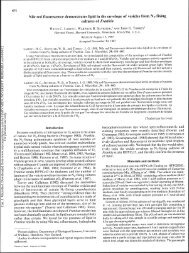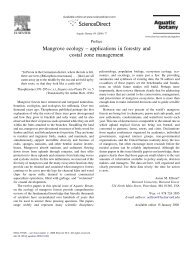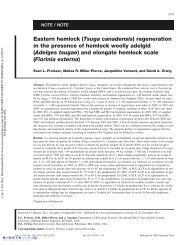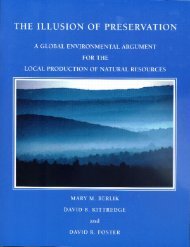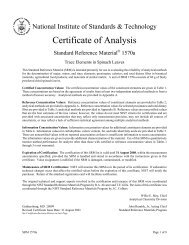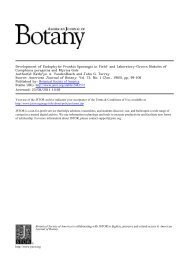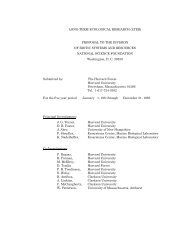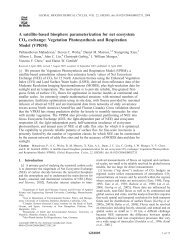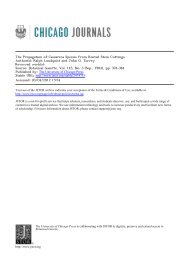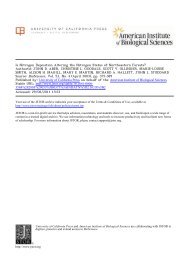Abstracts of Papers - Harvard Forest - Harvard University
Abstracts of Papers - Harvard Forest - Harvard University
Abstracts of Papers - Harvard Forest - Harvard University
Create successful ePaper yourself
Turn your PDF publications into a flip-book with our unique Google optimized e-Paper software.
in the concept <strong>of</strong> "serial homology", and the more<br />
concise notion <strong>of</strong> strict homology which (by defini-<br />
tion) is due to descent. A historical perspective is<br />
particularly illuminating, especially as the basic<br />
principles <strong>of</strong> comparative morphology are largely<br />
conceived in a pre-evolutionary environment. Em-<br />
phasis will be placed on developmental analysis in<br />
comparative morphology as a basic process in the<br />
generation <strong>of</strong> the modular organism. Knowledge <strong>of</strong><br />
development can frequently illuminate comparative<br />
analysis. Examples will be cited where the organiza-<br />
tional plasticity almost defeats the possibility <strong>of</strong><br />
evolutionary morphological analysis in modular organ-<br />
isms.<br />
W. H. WAGNER, JR., Department <strong>of</strong> Botany, <strong>University</strong><br />
<strong>of</strong> Michigan, Ann Arbor, Michigan 48109. -<br />
Homology and the early<br />
plants.<br />
diversification <strong>of</strong> vascular<br />
Primitive vascular plants are the ones that first appeared<br />
in the fossil record, that possess simple life<br />
cycles,and are most similar to the outside group, the<br />
bryophytes. Because <strong>of</strong> their diversity, homology <strong>of</strong><br />
even major organs has been controversial. Theories<br />
like the Stelar Theory or the Telome Theory try to<br />
fit the morphics <strong>of</strong> plants into preconceived molds<br />
Objectivity is best accomplished by using classical<br />
tests <strong>of</strong> position, ontogeny, mature structure, and<br />
absence <strong>of</strong> intermediates. Evidence <strong>of</strong> early diversification<br />
<strong>of</strong> vascular plants comes from cladistic analysis<br />
<strong>of</strong> living groups, psilotopsids, lycopsids,<br />
equisetopsids, and polypodiopsids, together with the<br />
fossil remains <strong>of</strong> trimerophytes, zosterophytes, and<br />
rhyniophytes, a motley assemblage. Our problem is<br />
to connect different organs in different groups, because<br />
there are such large gaps, and intermediate<br />
stages or trends are lacking. How teratology fits<br />
into this is a question. In addition to varlous tissue<br />
types, the major organs are discussed:stem, root,<br />
leaf, sporangium, spore, gametophyte, gametangia,<br />
gametes, embryo, and foot. Because <strong>of</strong> homoplasy,<br />
homology is, by itself, not necessarily a criterion<br />
<strong>of</strong> relationship. At the tissue level, the stele provides<br />
a challenge; at the organ level, the foliar<br />
appendages. Parsimony suggests that at least in the<br />
case <strong>of</strong> the leaf, all <strong>of</strong> the appendages were originally<br />
emergences. The position <strong>of</strong> sporangia, so fundamental,<br />
apparently, in the early differentiation<br />
<strong>of</strong> vascular plants, is a good example, <strong>of</strong> the absence<br />
<strong>of</strong> intermediates, suggesting abrupt, rapid changes.<br />
There is a spectrum <strong>of</strong> degrees<br />
organs <strong>of</strong> early vascular plants<br />
to very questionable.<br />
<strong>of</strong> homology <strong>of</strong> the<br />
-- from very obvious<br />
Poster Session<br />
BASILE, DOMINICK V. and MARGARET R. BASILE<br />
Department <strong>of</strong> Biological Sciences, H. H.<br />
Lehman College <strong>of</strong> CUNY, Bronx, N.Y. 10468.<br />
- Auxin antagonist-induced desuppression<br />
<strong>of</strong> leaf primordia <strong>of</strong> Plagiochila arctica<br />
(Hepaticae): Possible integration <strong>of</strong><br />
auxin, ethylene and hydroxyproline-alterable<br />
proteins in correlative control <strong>of</strong><br />
cellular suppression.<br />
Two inhibitors <strong>of</strong> auxin transport, triiodobenzoic<br />
acid (TIBA) and N-l-naphthylphthalamic<br />
acid<br />
auxin action, i -<br />
(NPA), and an inhibitor <strong>of</strong><br />
(p-chlorophenoxy) isobutyric<br />
acid (PCIB), induced the same kind <strong>of</strong> pheno-<br />
Developmental and Structural Section 13<br />
variation in Plagiochila arctica Bryhn &<br />
Kaal. (Hepaticae) as do antagonists <strong>of</strong> ethy-<br />
lene synthesis/action and antagonists <strong>of</strong><br />
hydroxyproline-protein (hyp-protein) syn-<br />
thesis. This indicates that the two phyto-<br />
hormones and a cell surface protein sensi-<br />
tive to antagonists <strong>of</strong> hyp-protein synthesis<br />
play an integrated role in the correlative<br />
control <strong>of</strong> cellular suppression - primordium<br />
development. Auxin-induced ethylene syn-<br />
thesis and ethylene-induced cell surface<br />
hydroxyproline protein deposition correlated<br />
with suppressed development have been re-<br />
ported byothers, previously. This, however,<br />
is the first experimental evidence to impli-<br />
cate all three molecules, two phytohormones<br />
and a cell surface glycoprotein, in the same<br />
morphoregulatory system. This correlative<br />
control system conceivably plays an impor-<br />
tany role in other, if not all, groups <strong>of</strong><br />
land plants (Embryophyta).<br />
CAESAR, J. C. AND A. D. MACDONALD*. Department<br />
<strong>of</strong> Biology, Lakehead <strong>University</strong>, Thunder Bay,<br />
Ontario. P7B 5EI.<br />
- Comparison <strong>of</strong> early growth <strong>of</strong> vegetative and<br />
reproductive short shoots <strong>of</strong> Betula papyrifera.<br />
This study shows the cost to short shoot growth <strong>of</strong><br />
female inflorescence development. Expanding and<br />
flushing short shoot buds were collected from mature<br />
trees from April-June 1982. Quantitative analyses<br />
were made on fresh and FAA-fixed material for<br />
relative growth rates (RGR) <strong>of</strong> leaves and buds,<br />
specific leaf area (SLA), leaf area ratio (LAR), leaf<br />
area (LA) and number <strong>of</strong> leaf side nerve pairs (SNP).<br />
Material was partially dissected to determine whether<br />
the bud was reproductive or vegetative. Short shoot<br />
buds may be vegetative or may bear a female<br />
inflorescence; these buds may be proximal on a long<br />
shoot or terminal on a short shoot. Axillary short<br />
shoot buds flush later than 2-4 year old short shoot<br />
terminal buds, which flush later than 5-10 year old<br />
shoots. Mean RGR <strong>of</strong> 5-10 year old short shoot buds<br />
is greater than that <strong>of</strong> younger short-shoot buds. It<br />
is suggested that older short shoot buds are<br />
relatively autonomous and that the flushing long<br />
shoot exhibits an inhibitory influence on the<br />
proximal axillary buds and possibly on young short<br />
shoot terminal buds. Reproductive short shoots diffr<br />
from vegetative short shoots in that they have lower<br />
LAR's and leaf RGR's, higher SLA's, smaller LA's,<br />
fewer SNP's and they seem to grow more in length<br />
than in width. These findings are related to<br />
reproductive cost. The developing inflorescences<br />
act as preferred 'sinks' for resource allocation.<br />
CECICH, ROBERT A. <strong>Forest</strong>ry Sciences Laboratory,<br />
P.O. Box 898, Rhinelander, WI 54501 -<br />
Histochemical and ultrastructural changes in<br />
microsporangia <strong>of</strong> jack pine during the winter.<br />
The development <strong>of</strong> jack pine (Pinus banksiana Lamb.)<br />
microsporangia from October to April was investigated.<br />
DNA, RNA, and protein content <strong>of</strong> sporogenous<br />
cells was measured with a microdensitometer at<br />
monthly intervals. DNA was unreplicated (2c) until<br />
March when DNA synthesis was first noted, coinciding<br />
with a loss <strong>of</strong> condensed chromatin. Protein staini<br />
ng i ncreased i n Apri . RNA stai-n i ng i ncreased i n<br />
December, followed by a loss <strong>of</strong> staining in January.




